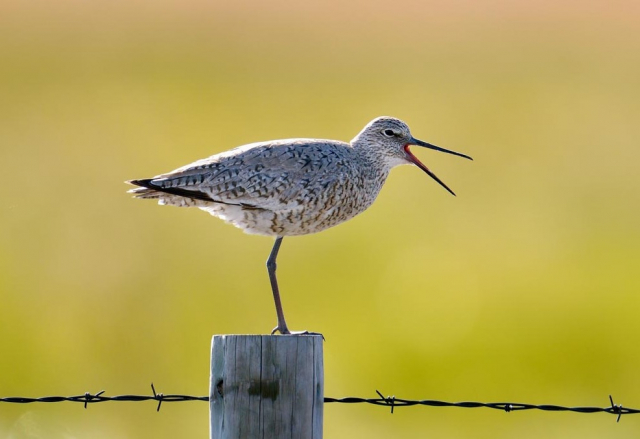Tringa semipalmata inornata
Status: Common regular spring migrant central and west, uncommon east. Uncommon, locally common, regular breeder north central and west. Fairly common regular fall migrant central and west, uncommon east.

Documentation: Specimen: UNSM ZM6611, 7 Jul 1902 Carns, Keya Paha Co.
Taxonomy: There are two subspecies, inornata (“Western Willet”) breeding from central Canada south to Colorado and Nebraska, wintering on the Gulf Coast and southward, and semipalmata (“Eastern Willet”) breeding from southeast Canada south on the Atlantic Coast to the Gulf Coast and West Indies (AviList 2025).
Nebraska birds are inornata; there are no records of semipalmata.
Spring: Apr 8, 9, 9 <<<>>> Jun 1, 1, 1
An earlier date is 4 Apr 2020 Hamilton Co.
Late dates above are away from the breeding range; later dates are 4 Jun 2025 Hall Co, 12 Jun 2017 Lancaster Co.
Spring migrants occur throughout the state, although it is uncommon in the east. Arrival is in mid-Apr, with a well-defined migration peak in the last week of Apr.
In 2013 surprising numbers appeared in the east. These easterly sightings included a good count of 24 in Washington Co 8 May, and 12 were at Lakes Babcock and North, Platte Co 28 May. An impressive 62 were at a site in Dixon Co 27 Apr 2024.
- High counts: 153 in the eastern Rainwater Basin 2-4 May 1997, 140 there 22 Apr 2000, and 127 there 24-25 Apr 1999.
Summer: Willets breed primarily in the western Sandhills region. Rosche (1982) apparently did not find Willets breeding in the high plains of the western Panhandle, remarking that breeding was “primarily confined to the sandhills region.” There is evidence that Willets breed sparingly further east, to the eastern edge of the Sandhills, notably in Holt Co. The several Holt Co records include an early breeding record (Ducey 1988), summer observations cited by Blake and Ducey (1991), a territorial bird 10 Jun 2011, and an adult and a young bird in Holt Co 10 Jul 2016. A copulating pair was at Pony Lake, Rock Co in early Jun (Ducey and Schoenenberger 1991), Two were in suitable breeding habitat in extreme western Knox Co 25 May 1998.
There are three mid-Jun reports for the eastern Rainwater Basin, 3-26 Jun 1937 Adams Co (Jorgensen 2012, Swenk 1937), 15 Jun 2001 Harvard WPA, Phelps Co (Jorgensen 2004), and 18 Jun 2016, and a “territorial” bird was near St Paul, Howard Co 9 Jul 2007, possibly a migrant.
- Breeding Phenology:
Eggs: 9 May- 25 Jun (Mollhoff 2022)
Young: 5 Jun- 20 Jul
- High counts: 60 in Sheridan Co 14 Jun 2004, and 40 near Ashby, Grant Co 18 Jun 2006.
Fall: Jun 23, 23, 24 <<<>>> Sep 15, 17, 17
Early dates above are away from the breeding range. There are earlier dates 17 Jun 2025 Cedar Co, 19-20 Jun 2004 at Lake McConaughy, Keith Co. A good early count was the 13 at Lakes North and Babcock, Platte Co 27 Jun 2023.
Later dates are 21 Sep 1997 Scotts Bluff Co, 21 Sep 2013 Garden Co, 26 Sep Rainwater Basin (Jorgensen 2012), 26 Sep 2024 (22) Holt Co, 2 Oct 2018 Douglas Co, 7 Oct 2006 Lake McConaughy, two on 8 Oct 2017 at Tamora WPA, Seward Co, and 24 Oct 2015 Conestoga Lake, Lancaster Co.
There are dramatically fewer fall reports than in spring, and Willets are uncommon in the east in fall. Willets likely vacate Nebraska soon after breeding; most leave before Sep, as there are only about 23 reports after Aug. In the eastern Rainwater Basin, Jorgensen (2012) identified two occurrence peaks, 9-21 Jul, presumably adults, and 11-17 Aug, likely juveniles. Early juveniles were one at Sora WMA, Fillmore Co 7 Jul 2023 and one in the eastern Rainwater Basin 25 Jul 2010.
- High counts: 20-30 near Bayard, Morrill Co on 8 Jul 2000, 29 in Lancaster Co 13 Aug 2006, 23 at Lake McConaughy 29 Jun 2001, and 22 in Holt Co 26 Sep 2024.
Images
Abbreviations
UNSM: University of Nebraska State Museum
WMA: Wildlife Management Area (State)
WPA: Waterfowl Production Area (Federal)
Literature Cited
AviList Core Team, 2025. AviList: The Global Avian Checklist, v2025. https://doi.org/10.2173/avilist.v2025.
Blake, L., and J. E. Ducey. 1991. Birds of the eastern Sandhills in Holt County, Nebraska. NBR 59: 103-132.
Ducey, J.E. 1988. Nebraska birds, breeding status and distribution. Simmons-Boardman Books, Omaha, Nebraska, USA.
Ducey, J.E., and J. Schoenenberger. 1991. Some birds of the Pony Lake area of the eastern Sandhills, Nebraska. NBR 59: 55-58.
Jorgensen, J.G. 2004. An overview of shorebird migration in the eastern Rainwater Basin, Nebraska. Nebraska Ornithologists’ Union Occasional Paper No. 8. Nebraska Ornithologists’ Union, Lincoln, Nebraska, USA.
Jorgensen, J.G. 2012. Birds of the Rainwater Basin, Nebraska. Nebraska Game and Parks Commission, Lincoln, Nebraska, USA.
Mollhoff, W.J. 2022. Nest records of Nebraska birds. Nebraska Ornithologists’ Union Occasional Paper Number 9.
Rosche, R.C. 1982. Birds of northwestern Nebraska and southwestern South Dakota, an annotated checklist. Cottonwood Press, Crawford, Nebraska, USA.
Swenk, M.H. 1937. N.O.U. Cooperative Bird Migration List for Spring of 1937. NBR 5: 59-66.
Recommended Citation
Silcock, W.R., and J.G. Jorgensen. 2025. Willet (Tringa semipalmata). In Birds of Nebraska — Online. www.BirdsofNebraska.org
Birds of Nebraska – Online
Updated 22 Aug 2025



